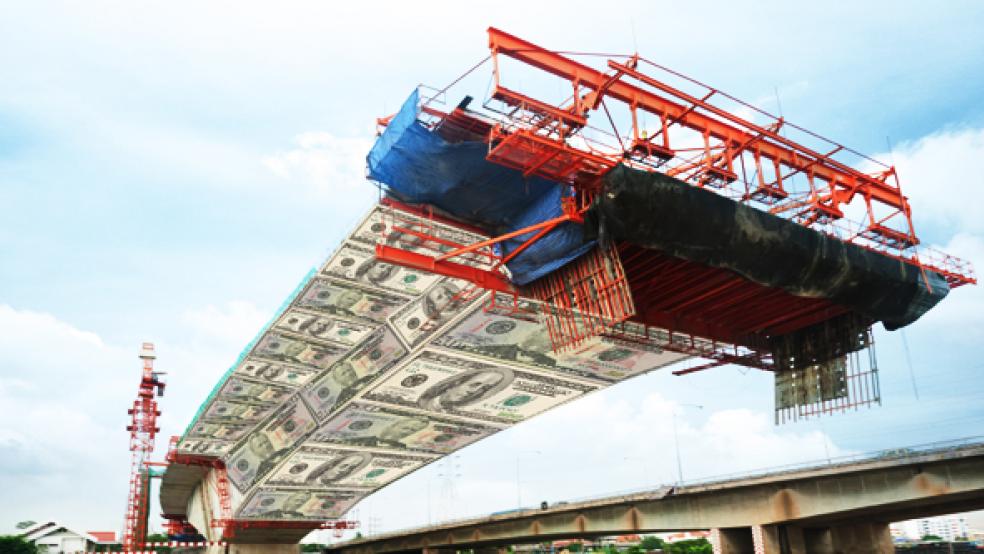Remember Alaska’s infamous “bridge to nowhere,” the poster project for wasteful government spending? Well it might finally be headed into construction since most of the approval criteria for a federal loan program was eliminated as part of the transportation bill signed into law by President Obama last month.

The Transportation Department rejected a request last year for a $300 million loan to help pay for the Knik Arm Bridge in Anchorage, one of two projects in the northernmost state that were notoriously tagged almost seven years ago as the nation’s most egregious examples of pork barrel spending.
But with the new rules in place, backers are confident they will receive financing to get the causeway built. “The process is becoming more objective,” said Shannon McCarthy, spokeswoman for the Knik Arm Bridge and Toll Authority. “There’s a stronger focus on project readiness.”
With this new transportation bill, lobbyists and transit advocates say the Obama administration ceded much of its control over the rapidly expanding credit loan program—officially known as TIFIA or the Transportation Infrastructure Finance and Innovation Act—that has become central for restoring the country’s stressed network of roads, rails and bridges.
A project’s potential economic benefits are no longer among the standards for awarding loans and loan guarantees, which will now be decided primarily by creditworthiness. And applicants must now be considered on a first-come, first-served basis, instead of competing against each other for a pool of money that Congress has increased tenfold to $1.7 billion for the next two years.
The infrastructure loans approved under TIFIA will now be decided on a first-come, first-served basis with the sole criteria largely being the ability to repay the debt used to build the project. That component was previously carried a 12.5 percent weight in assessing projects. | |
Criteria | Percent |
| National and regional significance: livability, economic benefits, improved safety, and enhancing U.S. competitiveness | 20% |
| Fosters a public-private partnership | 20% |
| Protects the environment | 20% |
| Creditworthiness | 12.5% |
| Creditworthiness | 12.5% |
| Creditworthiness | 5% |
| Share of TIFIA funding | 5% |
| Minimizes the use of federal grants | 5% |
Those changes elevate hopes that the bridge—which supporters say will enable more residential, commercial and industrial development—can clear a significant funding hurdle in Washington. The program was expanded as investing in infrastructure has become a crucial and contentious avenue for creating jobs.
Obama has highlighted infrastructure investment on the campaign trail as a way that government spending enables economic growth—sometimes to his own detriment as his comments have become fodder for negative ads and Republican talking points. “If you were successful, somebody along the line gave you some help,” Obama said last month. “Somebody helped to create this unbelievable system that we have that allowed you to thrive. Somebody invested in roads and bridges. If you’ve got a business, you didn’t build that. Somebody else made that happen.”
The “you didn’t build that” line may have referred to the infrastructure needed for companies to thrive, but it quickly reverberated around the country as an assault on private enterprise that groups such as Karl Rove’s Super PAC American Crossroads have used to blast Obama.
Presumptive Republican presidential nominee Mitt Romney has criticized the 2009 stimulus package as worsening the deficit by paying for wasteful infrastructure projects—including the $150,000 restoration of a 19th Century “bridge to nowhere” in New Hampshire.
“He went out and borrowed $787 billion and said that if we're allowing him as Congress allowed him to borrow that kind of money, that he would hold unemployment below 8 percent, and it hasn't been below 8 percent since," Romney said while standing in front of the unused crossing in May. “That’s your stimulus dollars at work — a bridge that goes nowhere. And so I hope that the president comes here, and takes a look at some of the stimulus program, there’s a long list by the way.”
Transportation Secretary Ray LaHood discussed the changes to TIFIA on a conference call with reporters late last month, saying it would jumpstart financing for construction, “Each dollar of federal funds can provide approximately $10 in TIFIA credit assistance, meaning $17 billion in loans through TIFIA. That in turn, can leverage $20 to $30 billion in investment.”
Supporters of the law say the changed TIFIA requirements will make the program more responsive to applicants, noting the risk to taxpayers is minimal because the program finances larger projects with loans instead of government grants -- recipients have to pay the money back. The new rolling deadlines creating the first-come, first-served mandate will make it easier for the government to be nimble.
“If you have a desire to use these tools, then they should move with the desired speed,” said Jack Basso, director of program finance and management at the American Association of State Highway and Transportation Officials. “The rolling deadlines were a response to customer complaints about sluggishness.”
Critics note that the government might no longer be able to get the biggest bang for its buck, since toll road projects with guaranteed revenue streams would have a better chance of approval than mass transit projects. Federal officials would disburse loans to state and regional authorities that got their applications to the government the fastest, rather than to programs that could do more to fuel economic growth.
“Cost-benefit analyses are pretty standard across the government, but DOT doesn’t have to do this anymore,” said Sarah Kline, policy director for the nonprofit Reconnecting America. “My concern is that we won’t get the best economic return on the dollars going out because of the types of projects that are ready to go.”
Congress also raised the share of TIFIA funding for a project from 33 percent to 49 percent. While the program has yet to register a default, taxpayers are exposed to more risk and the private co-financing the program was meant to encourage becomes displaced.
“You run the real risk that TIFIA money crowds out private dollars,” said Erich Zimmermann, senior policy analyst for the advocacy group Taxpayers for Common Sense. “The lower the stake taxpayers have in the project, the better it is for everybody.”
In addition to the Alaska bridge, other projects that were turned down also have a second chance and—compared to any new proposals—a head-start on the paperwork. Just five of the 26 TIFIA applications from last year were invited to participate, according to government records.
“If somebody applied before and didn’t get it, we anticipate they’ll send us a letter,” Chris Bertram, assistant Transportation secretary for budget and programs, said on the conference call with LaHood.
The re-write of the rules was relatively uncontroversial on the Environment and Public Works Committee chaired by Sen. Barbara Boxer, D-Calif., and the House Transportation and Infrastructure led by Rep. John Mica, R-Fla., according to those familiar with the matter.
Staff at the Senate and House committees responsible for crafting the transportation bill declined comment about how the changes were made, as did the Transportation Department when asked to provide additional context on why the administration allowed the criteria it had introduced to be scrapped without public objection.
Multiple industry and transportation advocates said there was little internal debate within the Senate or House about amending the guidance for TIFIA, although the actual transportation bill—the first passed since 2005—proved to be an agonizingly slow grind on Capitol Hill.
The previous standards, supporters of the new standards said, were often subjective, with the administration prioritizing livability and forms of social engineering over basic tests such as whether the revenues from tolls or sales taxes would be sufficient repay the loan.
Others like LaHood once praised the requirements that livability and economic benefits determine which projects received approval. When committing $300 million in loans to a Denver bus terminal and rail facility in 2010, he declared, "This project epitomizes the importance of livability principles to promote transportation mobility and strong communities.”
LaHood downplayed the removal of those standards when talking to reporters last month. "This is a sign that in a time of fiscal austerity, we can still do big things,” he said. “We have done a pretty good job with TIFIA. Now we have more resources."


